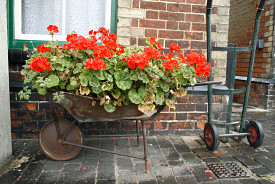Natural Sources of Nitrogen for Your Garden
 Recently, the leaves of my beautiful geraniums started to look a lot less beautiful. In fact they were downright yellow at the edges. With the dry spell we’ve been having, the “off” color definitely wasn't due to overwatering. A Google search showed that the problem with my posies was probably lack of nitrogen. This mineral is one of the most important nutrients for plants, necessary to their production of proteins, amino acids and DNA.
Recently, the leaves of my beautiful geraniums started to look a lot less beautiful. In fact they were downright yellow at the edges. With the dry spell we’ve been having, the “off” color definitely wasn't due to overwatering. A Google search showed that the problem with my posies was probably lack of nitrogen. This mineral is one of the most important nutrients for plants, necessary to their production of proteins, amino acids and DNA.
So I called the savviest gardening expert I know – my mother – for advice on how to naturally supplement my geraniums’ diet and give them the nitrogen they crave. Her immediate response: “Coffee grounds.”
Coffee Grounds
Mom was right. No-cost and readily available, coffee grounds are an excellent way to add nitrogen to your garden. In the process of decomposition, the leftovers from your morning cup of java give off nitrogen, phosphorus, and potassium. Mix the grounds gently into your soil, or add to the compost. In the latter case, make sure grounds are fairly dry so they don’t interfere with the aerobic quality of your pile. Though coffee beans are naturally acidic, the brewing process basically neutralizes the acid content.
Higher-Nitrogen Compost
Speaking of composting, it’s a great way to reduce landfills and replenish the earth. However, the typical mix of compostable materials may not satisfy the needs of nitrogen-loving crops like tomatoes, spinach, cabbage, corn, and potatoes. High-protein substances and fresh greens are best for boosting the compost's nitrogen level. Examples are:
- alfalfa
- meal ground from cottonseed or soy
- composted manure or chicken droppings
- fresh lawn clippings (free of toxic herbicide and pesticide)
- fresh fruit and vegetable scraps.
Seaweed is also a good source, though you'll have to wait about 15 weeks for its cellulose content to break down enough to release nitrogen.
NOTE: Your municipality may have regulations concerning what types of materials are permitted in your compost heap. This is not an arbitrary restriction, but designed for effective pest control in Houston and other large cities.
Garden Management
Another way to enrich your soil with nitrogen is careful management. Rotate your plants, following a high-nitrogen-consuming veggie or flower with one that needs much less. Or plant legumes, such as peas, beans, alfalfa or clover. Leguminous cover crops, sown early in spring or in autumn, are excellent at nitrogen fixation – depositing nitrogen absorbed from the air into their root nodules. Just cut them down before they flower and become woody; then dig the plants under to work that nitrogen into the earth.
Add Nitrogen with Caution
Beware! Over-application of nitrogen is counterproductive. It may stimulate plants like tomatoes to grow disproportionately -- with strong, healthy stalks but stunted fruit -- and might even burn them, especially if it contacts their leaves. Excessive nitrogen might seep or run off into nearby water systems, causing accelerated algae growth. These algae produce toxins and bacteria that make water dangerous for drinking. In addition, they decrease or eliminate oxygen in the water, sickening or even killing the fish population.
Test your soil before enriching it with nitrogen, and apply in small quantities. Use mulch to reduce run-off. For expert advice, consult an experienced local landscaper.
Laura Firszt writes for networx.com.
Updated December 27, 2018.
Related Articles
Looking for a Pro? Call us (866) 441-6648

Landscaping Average Costs
Landscapers Experiences

Yard Cleanup By A Local Landscaper Who Cares About Customers

Tree Removal And Backyard Cleanup Make A New House Feel Like Home



